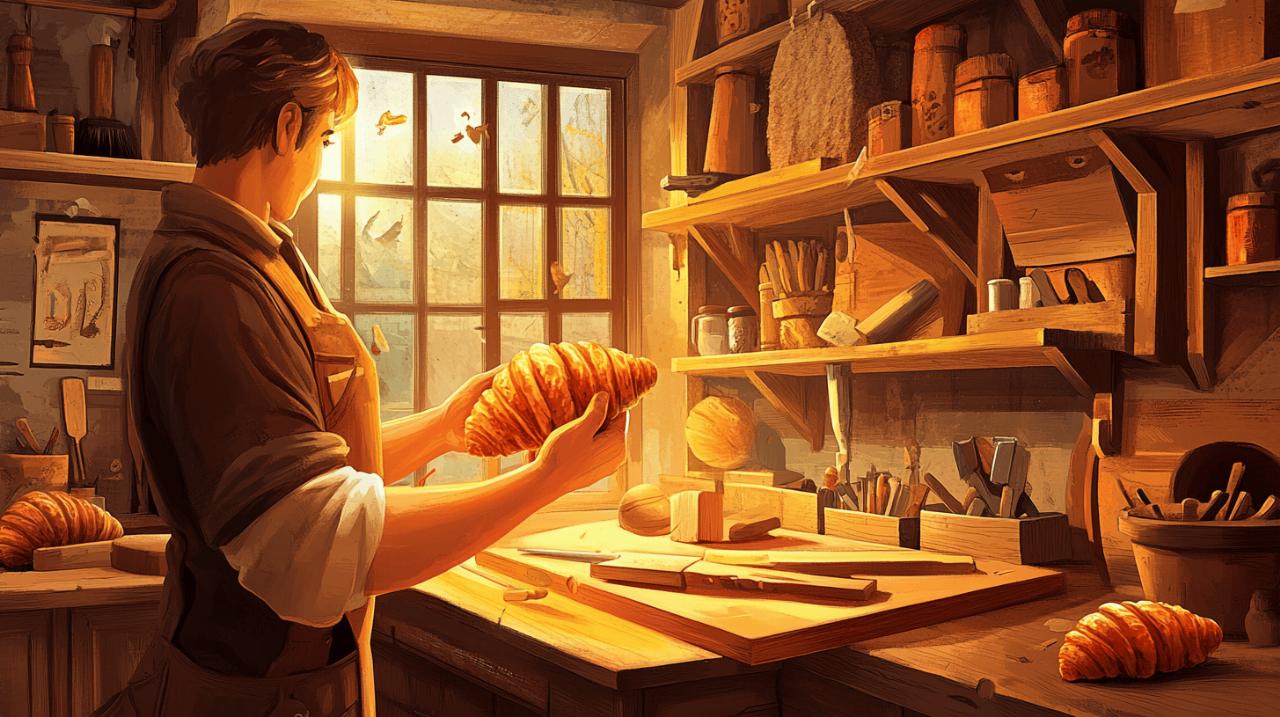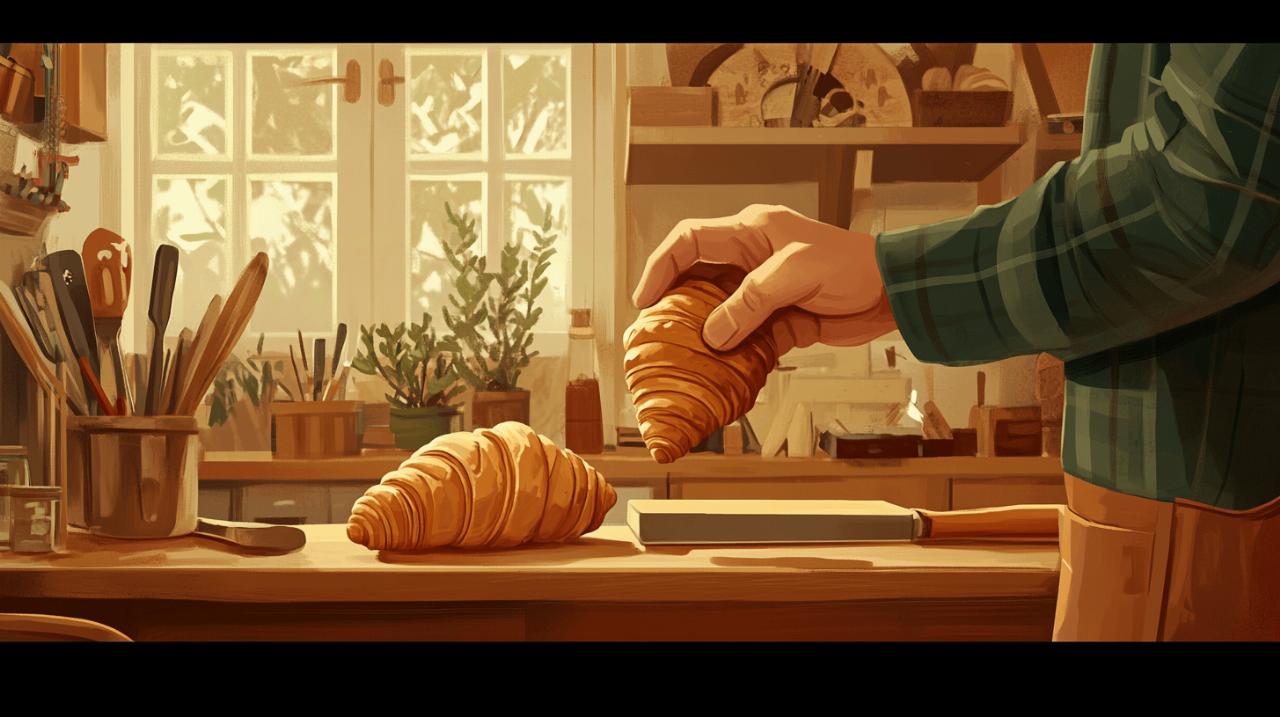Beyond Pastry: How the Croissant Essential Cutting Tool for Various Tasks Transforms Dough Scoring
The art of scoring dough transcends the boundaries of mere functionality, evolving into a creative expression that defines the character of every loaf. While the craft may seem straightforward at first glance, the tools employed in this delicate process play a pivotal role in determining both the visual appeal and structural integrity of baked goods. Among the arsenal of implements available to bakers, certain specialised cutting instruments have emerged as indispensable allies, transforming the way artisans approach dough scoring and elevating the final product to professional standards.
Understanding the croissant blade: a baker's secret weapon
The Anatomy of a Curved Scoring Tool
The bread lame represents one of the most refined instruments in the baker's toolkit, distinguished by its adjustable blade mechanism that allows for precision work across various dough types. This essential tool typically features a handle designed to accommodate replaceable razor blades, offering bakers the flexibility to maintain optimal sharpness throughout their work. The UFO lame has garnered particular attention within the baking community, achieving a rating of 38 out of 40 due to its exceptional safety features and reliable scoring performance. These curved implements facilitate the creation of distinctive patterns and the coveted bread ear that characterises artisan loaves. The design philosophy behind such tools considers not merely the cutting action itself but also the ergonomic comfort required during extended baking sessions. Surgical scissors have recently entered the conversation as an innovative alternative, particularly valued for producing textured designs that add visual interest to the crust. The X-acto knife stands as another versatile option, excelling in situations where straight, deep cuts are necessary to control oven spring effectively.
Why traditional blades fall short in artisan baking
Conventional cutting implements often prove inadequate when confronted with the specific demands of scoring proofed dough. The delicate nature of fermented dough requires a blade that can glide through the surface without causing deflation or tearing, a challenge that standard kitchen knives struggle to meet. Razor blades have emerged as a preferred solution for detailed decorative work, offering the keen edge necessary for intricate designs, though they demand careful handling and typically require replacement after approximately ten loaves to maintain their effectiveness. The bench scraper, whilst primarily intended for other purposes, can serve in scoring simple patterns, yet its limitations become apparent when attempting more complex designs. The fundamental issue with traditional blades lies in their inability to create the controlled depth and angle variations essential for proper oven spring and ear creation. Cold-proofed dough maintained at four degrees Celsius presents optimal conditions for scoring, and only purpose-designed tools can exploit these conditions to their fullest potential. The blade angles employed during scoring directly influence the final appearance and structure, with different angles serving distinct purposes in the scoring technique repertoire.
Mastering Dough Scoring Techniques with the Curved Blade
Achieving professional patterns and expansion control
The creation of scoring patterns ranges from straightforward single slashes to elaborate decorative motifs that showcase the baker's skill and artistic vision. Simple patterns such as crosses, squares, and wheat stalk designs provide an accessible entry point for those new to artisan bread making, whilst more advanced designs challenge experienced bakers to refine their blade control and depth management. The primary cut serves a functional purpose beyond aesthetics, requiring a depth of one quarter to one half inch executed at a ninety-degree angle to facilitate proper expansion during baking. Decorative cuts, by contrast, barely penetrate the surface and are applied at a forty-five-degree angle, serving purely ornamental purposes that enhance bread aesthetics without compromising structural integrity. The coveted ear creation demands particular precision, necessitating a quarter-inch depth at an angle between thirty and forty degrees to achieve the characteristic lift that distinguishes professional loaves. Understanding how dough temperature influences scoring outcomes proves essential, as properly cold-proofed dough responds more predictably to blade contact, yielding cleaner cuts and more pronounced patterns. The interplay between scoring depths and blade angles ultimately determines the success of the oven spring, that magical moment when the loaf achieves its final volume and shape within the heated environment.
How blade angle and depth affect your bake
The relationship between blade positioning and the resulting bake extends far beyond surface-level considerations, influencing the internal crumb structure and overall rise of the finished product. When a blade enters the dough at varying angles, it creates distinct pathways for steam to escape during baking, which in turn affects how the crust develops and how the loaf expands. A ninety-degree angle produces a straightforward opening that allows for maximum vertical expansion, ideal for round boules and rustic loaves where height takes precedence. Conversely, the shallow angle employed for ear creation encourages a lateral lift, producing that desirable flap of crust that catches the light and provides textural contrast. The depth of each cut must be calibrated according to the desired outcome, with surface-level scoring serving decorative functions whilst deeper incisions address the practical necessity of controlled expansion. Experienced bakers develop an intuitive understanding of these relationships through repeated practice, learning to adjust their technique based on the specific characteristics of each batch of dough. The importance of blade maintenance cannot be overstated in this context, as a dull edge will drag through the dough rather than slicing cleanly, compromising both the aesthetic and functional aspects of the scoring. Regular blade replacement, typically every ten to fifteen loaves, ensures consistent results and reduces the risk of tearing or deflating the carefully proofed dough.
Selecting your ideal dough scoring tool
Handle Comfort and Blade Quality for Precision Work
 The selection of an appropriate scoring implement requires careful consideration of multiple factors, with handle ergonomics ranking among the most critical elements for sustained comfort during extended baking sessions. Quality tools incorporate blade covers and guides that enhance safety whilst facilitating consistent scoring patterns, features that prove particularly valuable for those still developing their technique. The construction materials employed in both handle and blade components directly influence the tool's performance and longevity, with hardened steel blades maintaining their edge far longer than softer alternatives. Beginners should prioritise implements that emphasise safety features, such as the UFO lame or surgical scissors, which offer protection against accidental cuts whilst still delivering professional results. More experienced bakers often benefit from maintaining a collection of different tools, each suited to specific patterns or techniques within their repertoire. The bread lame stands as the professional standard, offering unmatched versatility through its adjustable blade system, though it demands a higher initial investment and a learning curve to master fully. The X-acto knife provides precision for detailed work but requires careful handling to prevent injury. Razor blades excel in creating intricate designs yet pose inherent risks that necessitate cautious use. Surgical scissors introduce unique textural possibilities with enhanced safety, though they offer fewer pattern options compared to blade-based alternatives. The bench scraper, whilst multi-functional and robust, lacks the finesse required for detailed decorative scoring.
The selection of an appropriate scoring implement requires careful consideration of multiple factors, with handle ergonomics ranking among the most critical elements for sustained comfort during extended baking sessions. Quality tools incorporate blade covers and guides that enhance safety whilst facilitating consistent scoring patterns, features that prove particularly valuable for those still developing their technique. The construction materials employed in both handle and blade components directly influence the tool's performance and longevity, with hardened steel blades maintaining their edge far longer than softer alternatives. Beginners should prioritise implements that emphasise safety features, such as the UFO lame or surgical scissors, which offer protection against accidental cuts whilst still delivering professional results. More experienced bakers often benefit from maintaining a collection of different tools, each suited to specific patterns or techniques within their repertoire. The bread lame stands as the professional standard, offering unmatched versatility through its adjustable blade system, though it demands a higher initial investment and a learning curve to master fully. The X-acto knife provides precision for detailed work but requires careful handling to prevent injury. Razor blades excel in creating intricate designs yet pose inherent risks that necessitate cautious use. Surgical scissors introduce unique textural possibilities with enhanced safety, though they offer fewer pattern options compared to blade-based alternatives. The bench scraper, whilst multi-functional and robust, lacks the finesse required for detailed decorative scoring.
Price Considerations and Long-Term Value for Bakers
The financial investment required for scoring tools varies considerably across the spectrum of available options, with basic implements accessible at modest prices whilst professional-grade equipment commands premium rates. Beginners often face the temptation to invest in comprehensive kits featuring numerous accessories, yet such purchases frequently prove unnecessary during the initial learning phase. The true value of a scoring tool manifests not in its initial cost but rather in its durability and the quality of results it consistently produces over time. Higher-priced implements typically incorporate superior materials and construction techniques that extend their operational lifespan, potentially offering better value than cheaper alternatives that require frequent replacement. The ongoing expense of blade replacement must factor into any cost analysis, as even the finest handles prove useless without sharp, effective cutting edges. Balancing immediate budget constraints against long-term needs requires honest assessment of one's commitment to artisan bread making and the frequency with which scoring tools will be employed. For occasional bakers, a simple razor blade holder may suffice, whilst serious enthusiasts and professional bakers will find that investing in quality tools pays dividends through improved consistency and reduced frustration. The relationship between price and performance proves far from linear, with mid-range options often delivering exceptional results that rival their more expensive counterparts. Careful research and consideration of individual needs should guide purchasing decisions rather than assuming that higher prices automatically guarantee superior outcomes.
Safety and Maintenance for Your Curved Scoring Blade
Proper handling techniques to prevent kitchen accidents
The extremely sharp nature of effective scoring blades necessitates unwavering attention to safety protocols throughout their use and storage. Establishing proper handling habits from the outset prevents the development of careless practices that could result in injury, particularly when working in the fast-paced environment of active baking sessions. Tools should always be stored with protective covers in place, shielding both the blade and the user from accidental contact when retrieving or replacing implements. The workspace surrounding the scoring area requires organisation and clarity, with blades placed in designated locations rather than left casually on countertops where they might be obscured by flour or dough. When executing scoring motions, bakers should position themselves to ensure that any slippage directs the blade away from the body rather than towards vulnerable areas. Concentration must remain focused during the actual scoring process, as distraction during this critical moment increases the likelihood of errors that could compromise both the loaf and personal safety. Children and untrained individuals should be kept at a safe distance from scoring operations, and tools must be secured immediately after use to prevent unauthorised handling. The development of consistent, deliberate movements through practice reduces the risk of accidents whilst simultaneously improving the quality of scoring results. Understanding the capabilities and limitations of each tool type allows bakers to select the appropriate implement for each task, avoiding situations where an unsuitable tool might behave unpredictably.
Keeping Your Tool Sharp and Ready for Consistent Results
The maintenance regimen applied to scoring tools directly determines their ongoing performance and the quality of cuts they produce across successive baking sessions. Regular inspection of blade condition allows bakers to identify deterioration before it significantly impacts results, ensuring that replacements occur at optimal intervals rather than after quality has already suffered. The recommendation to change blades every ten to fifteen loaves provides a general guideline, though actual replacement frequency may vary depending on dough characteristics and individual usage patterns. Proper cleaning procedures extend tool lifespan whilst preventing the accumulation of dried dough that could interfere with smooth cutting action or harbour unwanted microorganisms. Handles require periodic attention as well, with wooden components benefiting from occasional oiling to prevent drying and cracking, whilst synthetic materials need inspection for signs of wear or damage that might compromise grip security. Storage conditions influence tool longevity, with excessive moisture potentially causing rust on unprotected blades whilst overly dry environments may affect wooden handle integrity. The investment in quality blade maintenance translates directly into consistent scoring results, as properly maintained tools respond predictably and reliably across varied dough types and conditions. Developing systematic maintenance habits ensures that tools remain ready for immediate use whenever baking inspiration strikes, eliminating the frustration of discovering dull or damaged implements at critical moments. The relationship between tool care and baking success reinforces the broader principle that attention to detail in all aspects of the craft contributes to superior final products that justify the time and effort invested in their creation.



